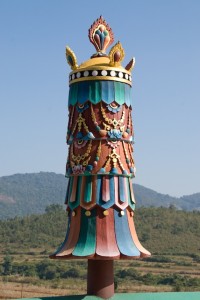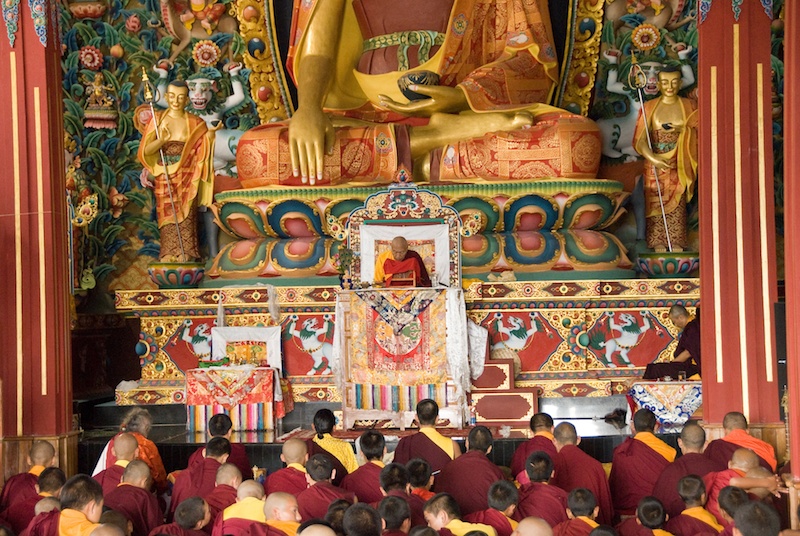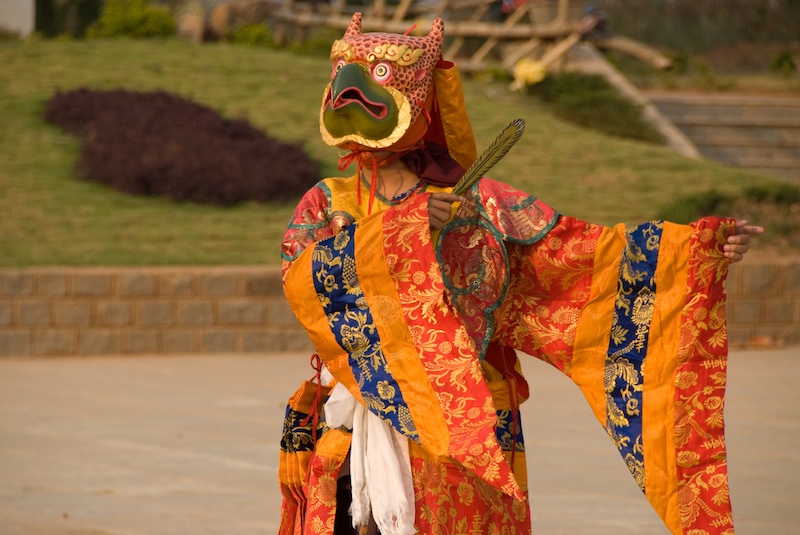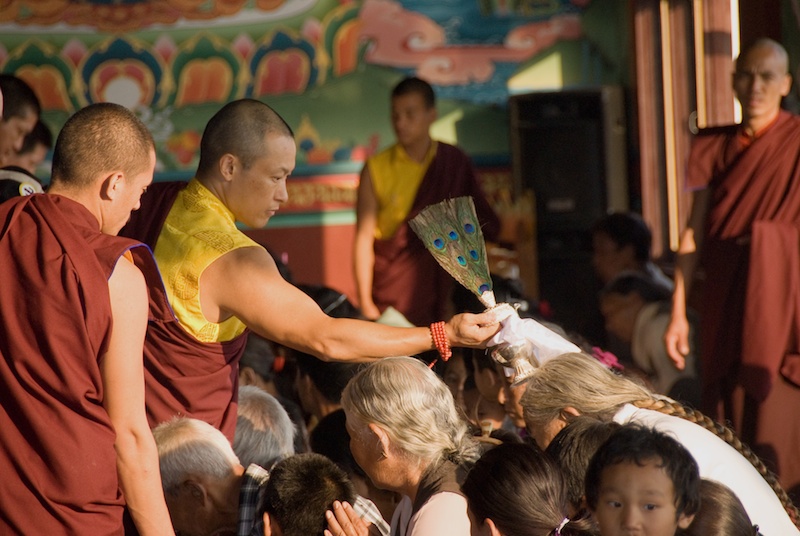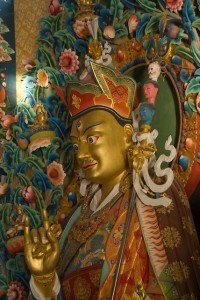Monday
Featured StoriesThe Terton and the Chodak in the Shambhala Terma Tradition
By Walker Blaine
This article is an edited extract from The Great River Of Blessings, a digital book about the Rinchen Terdzo, conferred by His Eminence Namkha Drimed Rinpoche on the Kongma Sakyong Mipham Rinpoche in the winter of 2008 – 2009. During the course of the empowerments, I became interested in the role of the chodak, the immediate successor of a terton. What follows is a distillation of my research and interviews. The Great River Of Blessings is available as a free download at the Sakyong Foundation website.
Termas, or hidden treasures, are teachings concealed by Padmasambhava and other great masters during the initial spread of Buddhism in Tibet. Terma was created as a means to revitalize and strengthen the dharma in future times when both the world and the teachings would be threatened by degradation and loss of heart. Generally speaking, terma is a distinctive feature of the Nyingma lineage, the earliest Tibetan Buddhist tradition. Although most termas come to us through Padmasambhava, some originate from other lineage masters. These masters include Vimalamitra and Vairochana, who were Padmasambhava’s contemporaries, as well as the warrior-king Gesar of Ling, who is regarded as an emanation of Padmasambhava.
The Terton
Tertons, or treasure revealers, are rebirths of the twenty-five principle disciples of Padmasambhava, who were present when a terma teaching was originally given by Padmasambhava. Among those disciples, one would be chosen and given the command by Padmasambhava to reveal the teaching in future times as a terma. Additionally, tertons from eastern Tibet are sometimes rebirths of bodhisattva-warriors from Gesar’s era. Several recent tertons, such as Dilgo Khyentse Rinpoche, have revealed Gesar termas. Khenpo Jigme Phuntsok had a vision of the site where Gesar’s palace once stood in Golok, and a commemorative temple was built there in the 1990s. The terton who has discovered the greatest number of Gesar termas is His Eminence Namkha Drimed Rinpoche.
The Shambhala terma was received by Chogyam Trungpa Rinpoche from two sources: Gesar of Ling and the Rigden Kings. The Rigdens are enlightened rulers of the legendary kingdom of Shambhala, who are featured in the teachings of the Kalachakra tantra and who many Tibetans believe guided and inspired King Gesar. While the Kalachakra tantra is echoed in the Shambhala terma through the presence of the Rigdens, the Shambhala terma also has a connection with the Vajrakilaya tantra, which speaks extensively about the transformation of aggression. Chogyam Trungpa Rinpoche began discovering the Shambhala terma as a boy in eastern Tibet, all the while knowing the Shambhala teachings were destined for the West, or more broadly speaking, the modern world.
The Chodak
The chodak is a traditional role, vital to the transmission and preservation of a terma lineage. A chodak is the immediate successor of a terton, and the word is sometimes used to refer to a living holder of a terma lineage. Cho is the word for the dharma, or teachings of Buddhism, and dak is short for dakpo, which means both “lord” and “owner.” After a terma is discovered, a terton will give one or more chodaks the primary responsibility for propagating a terma. Sakyong Mipham Rinpoche once explained that a chodak is necessary because a terma is like gold, but people may not initially recognize it; the chodak has to make the gold visible to others so that they can clearly see the terma and attain realization through it.
To be able to do this, a chodak, as the owner of a terma, is given the authority and responsibility to create supporting texts so that a terma can be easily practiced and understood. Some terma texts are quite pithy and need liturgies and manuals to be practiced properly. Others might be too complicated to practice easily, so the chodak may need to create a simpler liturgy or practice manual. Chodaks may write sadhanas, practice manuals, ngondro texts, and auxiliary liturgies based on a terma text.
In some cases, the chodak was a disciple of Padmasambhava in a previous lifetime and was present when the terton originally received the contents of a terma. In other cases, the chodak was not a disciple of Padmasambhava, and instead was blessed to carry the terma forward by the power of Padmasambhava’s enlightened intention and aspiration.
Chodaks are appointed for particular qualities they might have in spreading the teachings. Sometimes a chodak will be someone with great power or influence because there will be great benefit if a particular terma spreads widely. In other cases, there may be more benefit if a terma does not spread widely, and the chodak might be more of a secret practitioner (someone very humble, with hidden qualities) and have only a few students. Terma lineages are often maintained in a family line. One reason for this is that blood descendants of realized teachers are considered to carry a particularly strong blessing and potential for realization.
Termas are transmitted in an empowerment, or abhisheka, from teacher to student like other vajrayana practice lineages. An empowerment is a direct presentation of a path of practice within the context of a particular tradition. Generally speaking, an empowerment is based on a teacher’s realization and is bestowed by means of an empowerment liturgy. Sometimes a terton will not use an empowerment liturgy because the terton is so closely connected to the source of the terma. However, since the chodak and subsequent lineage holders do not have the same mindstream as the terton, an empowerment liturgy is necessary in order to transmit the practice from the chodak’s time onward. In order to create a clear and reliable entry into a terma tradition for future students, a chodak will write an empowerment ritual if the terton did not write one.
The Shambhala Terma
In the context of the Shambhala terma, Chogyam Trungpa Rinpoche composed what we know as The Werma Sadhana based on the root texts in the Shambhala terma cycle. However, he never wrote an empowerment liturgy for this sadhana. In order to ensure the proper transmission and continuity of the Shambhala teachings, Sakyong Mipham Rinpoche composed the Rigden Abhisheka, based on the root texts of the terma. The Sakyong has also written several practices and commentaries to ensure a clear and stable transmission of the Shambhala tradition for future students. The Primordial Rigden Ngondro is an example of a practice written by a chodak to prepare people to enter a terma tradition with full confidence and understanding.
Chogyam Trungpa Rinpoche discovered his well-known terma, The Sadhana of Mahamudra, while on retreat in Bhutan in the late 1960s. At that time, he spontaneously gave a formal empowerment for this practice on a few occasions in India, but the empowerment ritual was never written down. His Holiness Dilgo Khyentse Rinpoche later wrote the empowerment text for The Sadhana of Mahamudra at the request of Sakyong Mipham Rinpoche. This was possible because of His Holiness Dilgo Khyentse Rinpoche’s extraordinary realization and an agreement between him and Chogyam Trungpa Rinpoche that if one of them could not finish his work, the other would finish it for him. Someone who attended one of Chogyam Trungpa Rinpoche’s empowerments in India remarked that The Sadhana of Mahamudra empowerment, bestowed by Sakyong Mipham Rinpoche, was quite similar to the one he received from the Trungpa Rinpoche.
It is my aspiration that this article will further an understanding of the depth of the terma tradition and the many roles fulfilled by Sakyong Mipham Rinpoche. I was inspired to investigate the purpose of the chodak during the three-month long Rinchen Terdzo bestowed on the Sakyong by His Eminence Namkha Drimed Rinpoche in 2009. The Rinchen Terdzo, or “Precious Treasury of Termas,” is a collection of nearly 900 terma teachings and empowerments that present the essence of the practice and realization transmitted within the Nyingma lineage. His Eminence Namkha Drimed Rinpoche received the Rinchen Terdzo directly from Chogyam Trungpa Rinpoche and was delighted to at last be able to pass this lineage of the Rinchen Terdzo on to the Sakyong.
In addition to his responsibilities as a chodak for the Shambhala terma, sovereign of Shambhala, and carrying the Nyingma lineages once held by his father, Sakyong Mipham Rinpoche also holds the Kagyu lineage transmission, which was bestowed on him by his father in 1985 during the Vajrayogini abhisheka in Marburg, Germany. May the Sakyong’s retreat bring all possible excellence, may the lineage of the Sakyongs and Shambhala thrive for hundreds of generations, and may we all realize the meaning of the profound riches of the Shambhala, Kagyu, and Nyingma teachings.
Walker Blaine completed his bachelor’s degree at Naropa University in Boulder, Colorado in 1986. After graduation, he spent the next 15 years practicing and working in rural retreat centers in North America. From 2001 to 2008, he divided his time between retreat, pilgrimage, and study in Asia and the West. He is a member of the Nalanda Translation Committee and lives in Halifax, Nova Scotia.
Walker’s two CDs of Buddhist music, Highland Eyes and Body Of Light can be sampled at iTunes and at http://www.highlandeyes.com.
Photo Credit: Christoph Schoenherr

